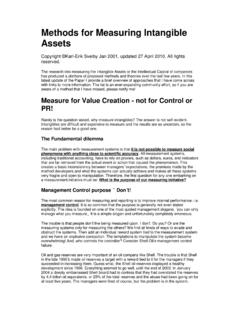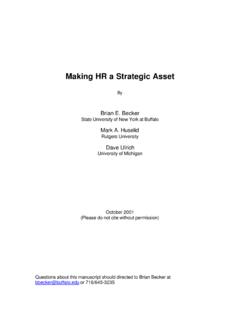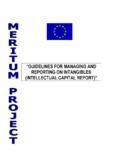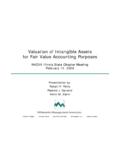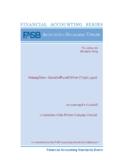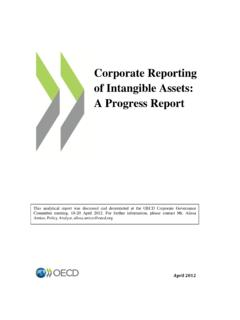Transcription of Six Key Principles for Measuring Human Capital …
1 Six Key Principles for Measuring Human Capital performance in your organization By Brian E. Becker State University of New York at Buffalo Mark A. Huselid Rutgers University Dave Ulrich University of Michigan February 2002. (Please do not cite without permission). Questions about this manuscript should directed to Brian Becker at or 716/645-3235. Draft Six Key Principles for Measuring Human Capital performance in your organization We hear a lot about the importance of intangibles as sources of competitive advantage, and in particular the importance of Human Capital . But if Human Capital is such an important asset, why don't we do a better job of managing Human Capital like an asset rather than a cost to be minimized.
2 Organizations often trumpet that people are our most important asset , and they may even believe it, but they have no way to translate that slogan into organizational practice. Properly valuing Human Capital starts with understanding how to measure Human Capital 's contribution to the success of the organization . Based on more than a decade of research, we've demonstrated that when organizations enable, develop and motivate Human Capital , the result is improved accounting profits and shareholder value [see inset]. While this research provides a compelling business case for managing Human Capital like a strategic asset, we find that both HR professionals and line managers often have difficulty translating this academic research into practice.
3 Managing Human Capital performance effectively requires new perspectives and new competencies on the part of both line managers and HR professionals. Drawing on both our research and our work with senior HR professionals and line managers, we've developed six key Principles for Measuring Human Capital performance so that it can be managed as a strategic asset. #1 Focus on the strategic impact of Human Capital . Human Capital is an illusive concept. Managers are not used to thinking in terms of Human Capital because accounting systems make it difficult to capitalize investments in skills and other intangibles . So what is the best way to measure Human Capital ?
4 First of all we have to remember that measures are answers to questions, not ends in themselves. Determining the appropriate measure depends on the question one is trying to answer. If your organization is looking to drive out costs and the HR function is being asked to justify its performance based on efficiency, you might focus on the cost of Human Capital ( annual expenditures on training or cost per 2. hire). If we compare Human Capital to another intangible, research and development, focusing on cost and efficiency would be equivalent to valuing the R&D function by the size of the annual R&D budget. Alternatively, if we are interested in questions about how intangibles drive strategy so we can do a better job managing firm performance , efficiency measures of this kind are a blunt instrument at best.
5 Another possible measure is the stock of Human Capital where the level is compared against a desirable benchmark. This approach might include measures such as hours of training per year, leadership competency levels, or other measures designed to capture the level of Human Capital in the firm. After all, we've been told there is a war for talent so presumably it's important to know how much talent you have. The R&D equivalent of focusing on stocks might be the number of new products developed per year, or even the number, education and experience level of the R&D staff. This has been a very common approach among HR professionals where the emphasis is on counts and activities such as number of employees trained per year, number of courses offered, etc.
6 These measures capture a type of functional performance , but they tell us nothing about the value of those outcomes. At best they are the first step in a long value chain that culminates in improved firm performance . At worst, they turn out to be well-intentioned initiatives with no evidence of any influence on the firm's strategy drivers. Line managers see them as overhead to be controlled, while HR professionals are hard pressed to demonstrate their contribution to the bottom line. By contrast, the real focus should be on the productive results of Human Capital . Consider the illustration of a college education. It is a classic example of Human Capital .
7 The value of a college education is not the cost of the tuition, or the number of years of education, but the increased earning power one derives from that education. Similarly, we should value Human Capital in the organization based on the performance of that Human Capital . By Human Capital , therefore, we mean the productive efforts of an organization 's workforce. By performance , we mean employee performance that effectively implements the firm's strategy. In short, the relevant Human Capital measures are the performance behaviors that influence the key strategy drivers in the organization . Returning to our R&D. analogy, the equivalent focus on productive results is to value R&D performance by the annual change in revenue attributable to new product ideas.
8 A simple example from the retail sector illustrates what we mean by Human Capital performance . Imagine that a retail business determined that one of the drivers of future sales 3. growth is improved customer satisfaction, which is in part driven by the quality of the buying experience. Where does Human Capital performance enter the picture? As a leading indicator, it is the foundation of subsequent revenue growth by the impact it has on the customer buying experience. In this industry, the buying experience is in part driven by front- line staff who are knowledgeable, timely, helpful and courteous. Those performance behaviors represent the productive results of Human Capital because of their impact on the performance drivers (customer buying experience, customer satisfaction, wallet-share) that ultimately drive revenues.
9 Managing Human Capital in this context means managing those performance behaviors. #2 Beware of Human Capital Alchemy. An organization cannot simply begin to collect different measures and all of a sudden expect to reveal hidden value where employees are traditionally viewed as a cost to be minimized and the HR function is focused on administrative efficiency and transactions. There are three steps to managing Human Capital as a strategic asset: the right perspective, the right HR system and the right performance measurement system. First, HR professionals and line managers both need a new perspective on the management of Human Capital . Line managers need to view HR as something more than administrative overhead and HR professionals need to take a shared responsibility for driving those business outcomes that have a significant Human Capital component.
10 Second, HR professionals and line managers need to take a shared responsibility for developing an HR system (hiring, rewards, development, etc.) that is aligned with the Human Capital requirements of the firm's strategic drivers. Third, measures designed to reflect Human Capital performance should focus on how well the HR system generates the employee performance behaviors required to drive the firm's key business outcomes (Principle #1). The first two steps provide the foundation for Human Capital value creation that is revealed in the third step. Management of Human Capital has to go hand in hand with Measuring Human Capital performance . Consider the example of Hi Tech, a software manufacturer headquartered in the Western Its innovative products have earned it recognition as an industry leader.

